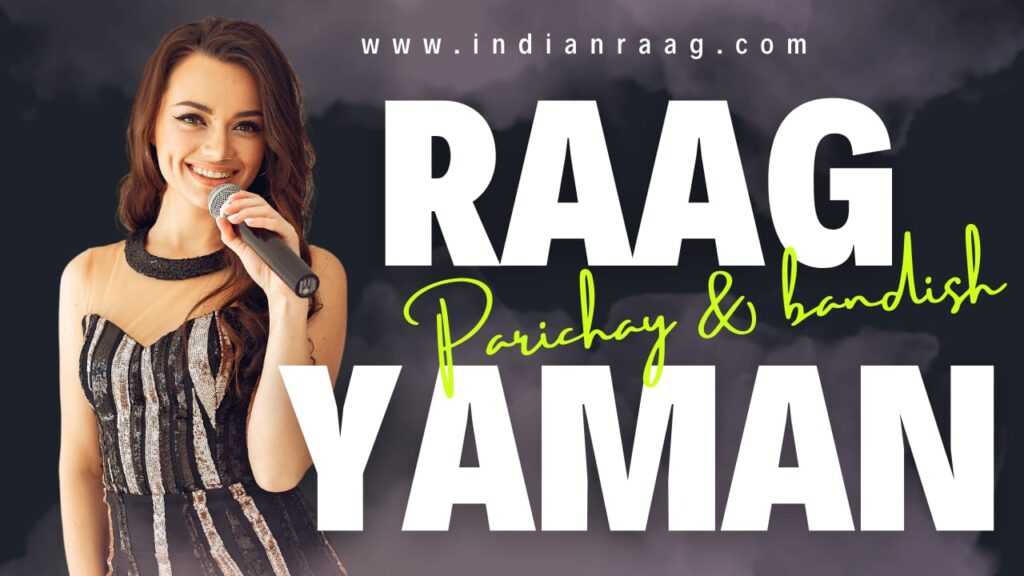Yaman Kalyan Raga
In this post, we present an introduction to Raag Yaman (Raag Yaman Parichay), covering the notes (Yaman Raag Notes), Taan, and an engaging bandish (Raag Yaman Bandish) titled “Yeri Aali,” complete with notations.

Raag Yaman Kalyan: Introduction
Raag Yaman is considered to have originated from the Kalyan Thaat. This raga is characterized by the use of the sharp Ma (Madhyam), with all other notes being natural (Shuddha). The Vadi (main note) is Ga (Gandhar), and the Samvadi (second important note) is Ni (Nishad). The raga is classified as a Sampurna-Sampurna Jati, meaning it uses all seven notes in both the ascent (Aaroh) and descent (Avroha). The ideal time for performing Raag Yaman is during the first part of the night.
Raag Yaman Aaroh Avroh:
- Aroh (Ascent): N R G M(t) D N S
- Avroh (Descent): S’ N D P M(t) G R S
- Pakad (Catchphrase): N R G M(t) G R S
Raag Yaman Parichay (Introduction):
- Thaat: Kalyan
- Vikrit Swar (Altered Note): Madhyam (Me) – Teevra (Sharp)
- Swar (Notes): All natural (Shuddha)
- Jati: Sampurna-Sampurna (Uses all seven notes in both Aaroh and Avroh)
- Vadi Swar (Dominant Note): Gandhar (Ga)
- Samvadi Swar (Sub-Dominant Note): Nishad (Ni)
- Gayan Samay (Time for Singing): Evening, 6 PM to 9 PM (First part of the night)
Yaman Raga
Raag Yaman is a prominent raga of the Kalyan family and holds a high place in Indian classical music. In some texts, Raag Yaman and Raag Kalyan are used interchangeably. There is a special version that uses both Shuddh and Teevra Madhyam, known as Yaman-Kalyan or Jaimini-Kalyan. This raga is also mentioned in Bharat Muni’s Natyashastra, an ancient text that is over 2000 years old. In Carnatic music, it is known as Kalyani.
The musical characteristics of Raag Yaman make it suitable for the first part of the night. Singing this raga evokes a unique mental and emotional experience, creating a sense of peace and balance that offers a divine experience to the listener.
Raag Yaman Bandish – "Yeri Aali Piya Bin"
Notes of Raag Yaman
Sthayi
N D P — | — R — S | G R G G | — — P P |
Ye – Ri – | – Aa – Li | Pi Ya Bi N | – – Sa Khi |
O | 3 | × | 2
G M G P | P D P P | N D N P P | R R S S |
Ka La Na Pa | Ra Ta Mo He | Gha – Ri Pa La | Chi Na Di n |
Antara
P P S’ S’ | S’ — S’ S’ | S’ — N D | N D P P |
Ja b Se Pi |Ya – Pa r | De – Sa Ga | Va n Ki Nho |
O | 3 | × | 2
P G R S’ | N D P P | D N D P | R R S S |
Ra Ti Ya Ka | Ta Ta Mo He | Ta – – Re | Gi Na Gi Na |
O | 3 | × | 2
Raag Yaman Taan – Sthayi [8 Beats]:
Ni Re, Ga Re, Ni Re, Sa~ | Pa Me, Ga Re, Ga Re, Sa~
Ga Me, Pa Me, Ga Me, Pa Me | Ga Me, Pa Me, Ga Re, Sa~
Ni Re, Ga Me, Pa Dha, Ma Pa | Ga Me, Pa Me, Ga Re, Sa~
Ni Re, Ga Me, Dha Ni, Sa~ | Sa Ni, Dha Pa, Me Ga, Re Sa
Yaman Raag Taan – Antara [8 Beats]:
Ga Me, Dha Ni, Sa Ni, Dha Pa | Ga Me, Dha Ni, Sa~ Ni Sa~
Sa Ni, Dha Pa, Me Pa, Ga Me | Dha~ Ni~ Sa Dha, Ni Sa~
How To Read Sargam Notes
Komal (Flat) Notes: These are represented by “(k)” or “_” to indicate a flattened note. For example:
- Komal Ga: Ga(k) or Ga
- Komal Re: Re(k) or Re
- Komal Dha: Dha(k) or Dha
- Komal Ni: Ni(k) or Ni
Note: In exams, you can write notes like Re, Ga, Dha, Ni in this manner.
Tivra (Sharp) Notes: These are represented by “(t)” or “Me” to indicate a sharp note. For example:
- Tivra Ma: Ma(t) or Me
Swar Extension: To indicate that a note should be prolonged, use a “-” after the note.
Fast Notes: Notes written together, like “ReGa,” indicate that they are played quickly or in one beat.
Mandar Saptak (Lower Octave) Notes: A dot below the note indicates it is from the lower octave.
- Example: .Ni = Lower octave Ni
Taar Saptak (Higher Octave) Notes: A line above or a special symbol indicates the note is from the higher octave.
- Example: Sa = Higher octave Sa
Thank You for Visiting!
We are so grateful for your visit and interest in our content! Your support means the world to us, and we hope you found what you were looking for. Whether you’re here to learn about music, explore new ideas, or just curious, we’re glad to have you. Don’t forget to subscribe, follow, or bookmark our page for more updates and insights. If you have any questions or suggestions, feel free to reach out—we love hearing from our community!
Thank you once again, and we hope to see you back soon!
